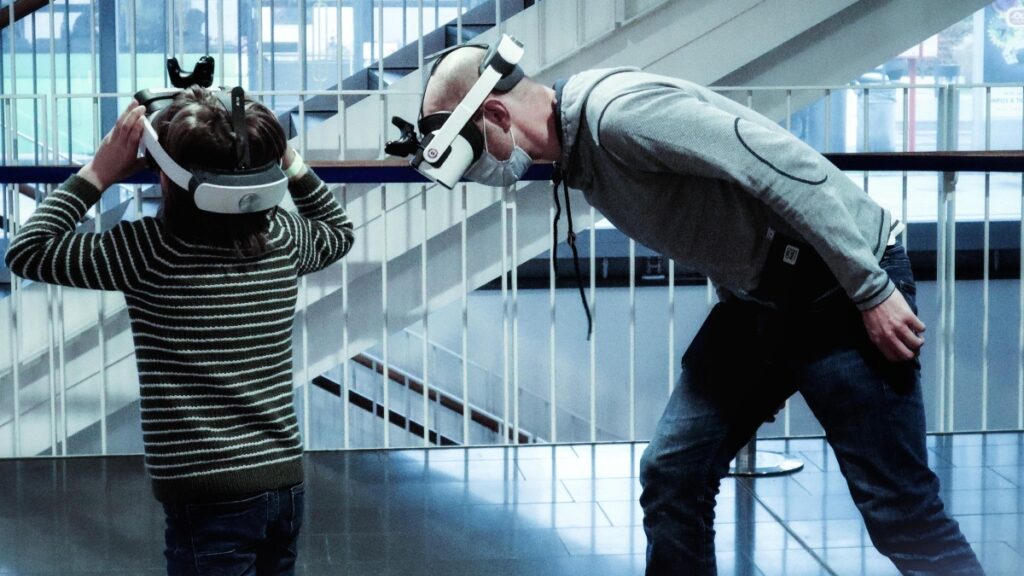
The intersection of artificial intelligence (AI) and virtual reality (VR) is creating transformative experiences in gaming, education, healthcare, and beyond. Here’s how AI is revolutionising VR:
Improving user experience
- Realistic interactions: AI enhances the realism in VR by making interactions more natural and dynamic. For example, AI can simulate more life-like NPC behaviours, where characters respond with appropriate gestures, facial expressions, and dialogue based on user actions or emotional cues detected through VR interfaces.
- Adaptive environments: AI can alter VR environments in real-time based on user behaviour or preferences. This could mean changing the difficulty of a game, adjusting the mood of a scene, or even modifying physical laws within the virtual world to suit or challenge the user.
- Personalisation: By analysing user data like movement patterns, eye tracking, or voice commands, AI can tailor VR experiences to individual users. This could mean customising the narrative of a VR story or adapting a training simulation to focus on areas where the user needs more practice.
Enhancing navigation and interaction
- Natural Language Processing (NLP): AI-driven NLP allows for more intuitive interaction in VR through voice commands. This not only makes navigation easier but also enhances the feeling of immersion by allowing verbal communication with virtual entities.
- Gesture recognition: AI improves gesture recognition, enabling more natural control over VR environments without the need for traditional controllers. This can make VR experiences more accessible and less cumbersome.
- AI-assisted movement: In VR, AI can predict and smooth out user movements, reducing issues like motion sickness by anticipating user actions and adjusting the VR environment accordingly.
Content creation and optimisation
- Procedural generation: AI can generate vast, varied virtual worlds or scenarios on-the-fly, providing endless content for exploration in VR games or educational experiences. This reduces the workload on developers while offering unique experiences to each user.
- Real-time rendering: AI can optimise graphics on-the-fly, ensuring high-quality visuals even on hardware with less computational power, making VR more accessible.
- Dynamic storytelling: In narrative-driven VR, AI can alter the storyline based on user choices, providing a bespoke narrative experience akin to having a personal storyteller.
Training and simulation
- VR for education and training: AI in VR can simulate complex scenarios for training purposes, from medical procedures to flight simulations, where AI can control the behavior of elements within the scenario, offering realistic feedback and adapting to the learner’s performance.
- Therapeutic applications: In mental health, AI can monitor user reactions within VR therapy sessions, adjusting scenarios to better suit therapeutic goals or learning from user data to personalise treatment plans.
Challenges and considerations
- Privacy and data security: With AI analysing vast amounts of user data for personalisation, privacy concerns are paramount. Ensuring this data is used ethically and securely is crucial.
- Technical limitations: Despite advancements, there are still challenges in latency, computational power needed for real-time AI processing, and the seamless integration of AI with VR hardware.
- Ethical use of AI: There’s an ongoing debate about AI’s role in content creation, especially concerning copyright issues when AI generates content based on existing works or styles.
- Human interaction: While AI can simulate human-like interactions, the depth of truly human conversation or empathy is hard to replicate, which can be a limitation in scenarios requiring deep emotional or social engagement.
Future prospects
- AI-driven holographic interfaces: Future VR might integrate AI with holographic technology, providing even more immersive experiences where AI controls not just what you see but how you interact with it.
- AI for social VR: As VR becomes a platform for social interaction, AI could facilitate better social experiences by managing avatars, moderating interactions, or even generating dynamic group activities based on collective interests.
- Cross-industry applications: From architecture to sports training, AI-enhanced VR could offer new ways to visualise, simulate, and interact with environments or scenarios previously unimaginable.
In conclusion, AI is not just an add-on but a fundamental enhancer of VR, making virtual experiences more engaging, personalised, and accessible. As these technologies continue to evolve, they promise to redefine our concept of reality, interaction, and learning in profound ways. However, the journey involves navigating complex technical, ethical, and privacy landscapes to fully harness AI’s potential in VR.
(This article has been contributed by Chaitanya Chinchlikar, the chief technology officer at Whistling Woods International. He has had a multi-faceted two-decade career in the film, media & entertainment industry. Over the past 15 plus years at the institute, he has worked towards strengthening India’s M&E education landscape in general and film education in particular, both in higher education and in India’s K-12 education. He has also spearheaded Whistling Woods’ initiatives to work with emerging technologies to develop curriculum around them and then introduce them into the education at the institute. AnimationXpress does not necessarily subscribe to these views.)
Also read: AI in gaming: Transforming the virtual experience
Also read: AI in animation: The evolution of a new frontier in creativity


